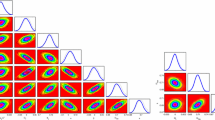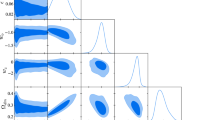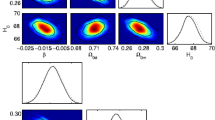Abstract
Current observations indicate that 95% of the energy density in the universe is the unknown dark component. The dark component is considered composed of two fluids: dark matter and dark energy. Or it is a mixture of these two dark components, i.e., one can consider it an exotic unknown dark fluid. With this consideration, the variable generalized Chaplygin gas (VGCG) model is studied with not dividing the unknown fluid into dark matter and dark energy parts in this paper. By using the Markov Chain Monte Carlo method, the VGCG model as the unification of dark sectors is constrained, and the constraint results on the VGCG model parameters are, n = 0.00057 +0.0001+0.0009−0.0006−0.0006 , α = 0.0015 +0.0003+0.0017−0.0015−0.0015 and B s = 0.778 +0.016+0.030−0.016−0.035 , obtained by the cosmic microwave background data from the 7-year WMAP full data points, the baryon acoustic oscillation data from Sloan Digital Sky Survey (SDSS) and 2-degree Field Galaxy Redshift (2dFGRS) survey, and the Union2 type Ia supernova data with systematic errors. At last, according to the evolution of deceleration parameter it is shown that an expanded universe from deceleration to acceleration can be obtained in VGCG cosmology.
Similar content being viewed by others
References
Riess A G, Filippenko A V, Challis P, et al. Observational evidence from supernova for an accelerating universe and a cosmological constant. Astrophys J, 1998, 116: 1009–1038
Spergel D N, Verde L, Peiris H V, et al. First year Wilkinson Microwave Anisotropy Probe (WMAP) Observations: Determination of cosmological parameters. Astrophys J Suppl, 2003, 148: 175–194
Pope A C, Matsubara T, Szalay A S, et al. Cosmological parameters from eigenmode analysis of sloan digital sky survey galaxy redshifts. Astrophys J, 2004, 607: 655–660
Feng C, Wang B, Abdalla E, et al. Observational constraints on the dark energy and dark matter mutual coupling. Phys Lett B, 2008, 665: 111–119
He J H, Wang B, Abdalla E. Stability of the curvature perturbation in dark sectors’ mutual interacting models. Phys Lett B, 2009, 671: 139–145
Wang B, Zang J, Lin C Y, et al. Interacting dark energy and dark matter: Observational constraints from cosmological parameters. Nucl Phys B, 2007, 778: 69–84
Wang B, Gong Y G, Abdalla E. Transition of the dark energy equation of state in an interacting holographic dark energy model. Phys Lett B, 2005, 624: 141–146
Cui J, Zhang X. Cosmic age problem revisited in the holographic dark energy model. Phys Lett B, 2010, 690: 233–238
Lu J B, Wu Y B, Jin Y Y, et al. Investigate the interaction between dark matter and dark energy. Res Phys, 2012, 2: 14–21
Lu J B, Ma L N, Liu M L, et al. Time variable cosmological constant of holographic origin with interaction in Brans-Dicke theory. Int JMod Phys D, 2012, 21 1250005
Kamenshchik A Y, Moschella U, Pasquier V. An alternative to quintessence. Phys Lett B, 2001, 511: 265–268
Guo Z K, Zhang Y Z. Cosmology with a variable Chaplygin gas. Phys Lett B, 2007, 645: 326–329
Bento M C, Bertolami O, Sen A A. Generalized Chaplygin gas, accelerated expansion and dark energy-matter unification. Phys Rev D, 2002, 66: 043507
Lu J B, Xu L X, Li J C, et al. Constraints on modified Chaplygin gas from recent observations and a comparison of its status with other models. Phys Lett B, 2008, 662: 87–91
Lu J B, Xu L X, Wu Y B, et al. Combined constraints on modified Chaplygin gas model from cosmological observed data: Markov chain Monte Carlo approach. Gen Rel Grav, 2011, 43: 819–832
Lu J B, Xu L X. Constraints on variable Chaplygin gas model from Type Ia supernovae and baryon acoustic oscillations. Mod Phys Lett A, 2010, 25: 737–747
Wu P X, Yu H W. Generalized Chaplygin gas model: Constraints from Hubble parameter versus redshift data. Phys Lett B, 2007, 644: 16–19
Lu J B, Gui Y X, Xu L X. Observational constraint on generalized Chaplygin gas model. Eur Phys J C, 2009, 63: 349–354
Komatsu E, Smith K M, Dunkley J, et al. Seven-Year Wilkinson Microwave Anisotropy Probe (WMAP) Observations: Cosmological interpretation. Astrophys J Suppl, 2011, 192: 18
Percival W J, Reid B A, Eisenstein D J, et al. Baryon acoustic oscillations in the Sloan Digital Sky Survey Data Release 7 galaxy sample. Mon Not Roy Astron Soc, 2010, 401: 2148–2168
Amanullah R, Lidman C, Rubin D, et al. Spectra and light curves of six type Ia supernovae and the Union2 compilation. Astrophys J, 2010, 716: 712–738
Ma C P, Bertschinger E. Cosmological perturbation theory in the synchronous and conformal Newtonian gauges. Astrophys J, 1995, 455: 7–25
Hwang J, Noh H. Gauge-ready formulation of the cosmological kinetic theory in generalized gravity theories. Phys Rev D, 2001, 65: 023512
Lewis A, Bridle S. Cosmological parameters from CMB and other data: A Monte-Carlo approach. Phys Rev D, 2002, 66: 103511
Burles S, Nollett K M, Turner M S. Primordial nucleosynthesis with a varying fine structure constant: An improved estimate. Astrophys J, 2001, 552: L1
Riess A G, Macri L, Casertano S, et al. A redetermination of the Hubble constant with the Hubble space telescope from a differential distance ladder. Astrophys J, 2009, 699: 539–563
Xu L X, Wang Y T, Noh H. Unified dark fluid with constant adiabatic sound speed and cosmic constraints. Phys Rev D, 2012, 85: 043003
Xu L X, Lu J B, Wang Y T. Revisiting generalized Chaplygin gas as a unified dark matter and dark energy model. Eur Phys J C, 2012, 72: 1883
Xu L X, Wang Y T. Observational constraints to Ricci dark energy model by using: SN, BAO, OHD, fgas data sets J Cosmol Astropart Phys, 2010, 06: 002
Xu L X, Wang Y T. Cosmic constraint to DGP brane model: Geometrical and dynamical perspectives. Phys Rev D, 2010, 82: 043503
Lu J B, Wang W P, Xu L X, et al. Does accelerating universe indicates Brans-Dicke theory. Eur Phys J Plus, 2011, 126: 92
Lu J B, Wu Y B, Xu L X. Constraint on the kinematical and dynamical model from the latest obervational data. Mod Phys Lett A, 2010, 25: 3033
Lu J B, Saridakis E, Setare M R, et al. Observational constraints on holographic dark energy with varying gravitational constant. J Cosmol Astropart Phys, 2010, 03: 031
Lu J B, Wang Y T, Wu Y B, et al. Cosmological constraints on the generalized holographic dark energy. Eur Phys J C, 2011, 71: 1800
Lu J B, Xu L X, Liu M L. Constraints on kinematic models from the latest observational data. Phys Lett B, 2011, 699: 246–250
Eisenstein D J, Hu W. Baryonic features in the matter transfer function. Astrophys J, 1998, 496: 605–614
Zhang X, Wu F Q, Zhang J F. New generalized Chaplygin gas as a scheme for unification of dark energy and dark matter. J Cosmol Astropart Phys, 2006, 0601: 003
Cao S, Liang N, Zhu Z H. Interaction between dark energy and dark matter: Observational constraints from H(z), BAO, CMB and SNe Ia. arXiv: 1105.6274
Cao S, Liang N, Zhu Z H. Testing the phenomenological interacting dark energy with observational H(z) data. arXiv: 1012.4879
Guo Z K, Ohta N, Tsujikawa S. Probing the coupling between dark components of the universe. Phys Rev D, 2007, 76: 023508
Pan Y, Cao S, Gong Y G, et al. Testing the interaction model with cosmological data and gamma-ray bursts. arXiv: 1211.0184
Liao K, Pan Y, Zhu Z H. Observational constraints on new generalized Chaplygin gas model. arXiv: 1210.5021
Cao S, Zhu Z H, Liang N. Observational constraints on interacting dark matter model without dark energy. Astron Astrophys, 2011, 529: A61
Guo Z K, Zhang Y Z. Interacting phantom energy. Phys Rev D, 2005, 71: 023501
Author information
Authors and Affiliations
Corresponding author
Rights and permissions
About this article
Cite this article
Lu, J., Chen, L., Xu, L. et al. Comparing the VGCG model as the unification of dark sectors with observations. Sci. China Phys. Mech. Astron. 57, 796–800 (2014). https://doi.org/10.1007/s11433-013-5300-5
Received:
Accepted:
Published:
Issue Date:
DOI: https://doi.org/10.1007/s11433-013-5300-5




